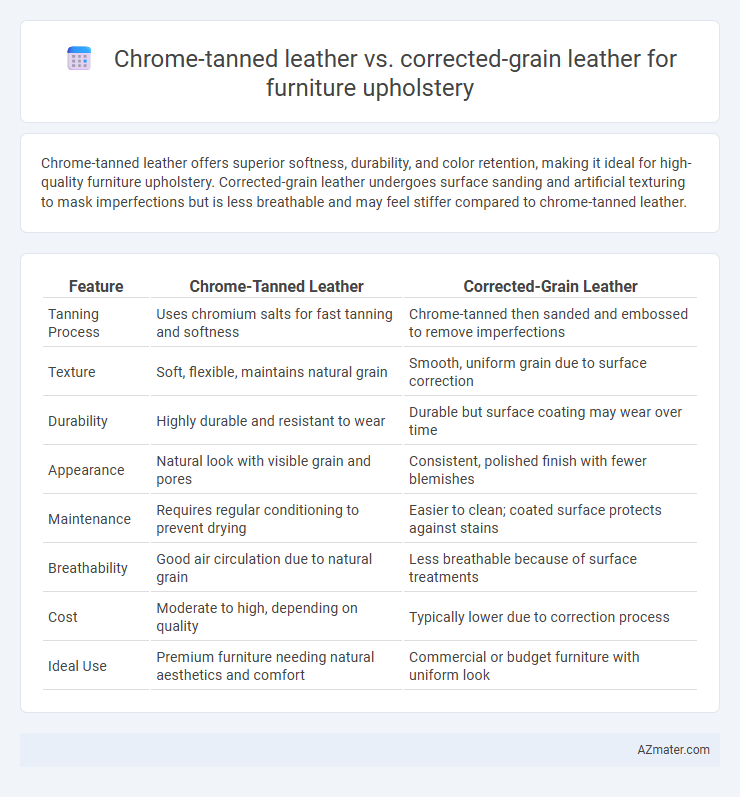Chrome-tanned leather offers superior softness, durability, and color retention, making it ideal for high-quality furniture upholstery. Corrected-grain leather undergoes surface sanding and artificial texturing to mask imperfections but is less breathable and may feel stiffer compared to chrome-tanned leather.
Table of Comparison
| Feature | Chrome-Tanned Leather | Corrected-Grain Leather |
|---|---|---|
| Tanning Process | Uses chromium salts for fast tanning and softness | Chrome-tanned then sanded and embossed to remove imperfections |
| Texture | Soft, flexible, maintains natural grain | Smooth, uniform grain due to surface correction |
| Durability | Highly durable and resistant to wear | Durable but surface coating may wear over time |
| Appearance | Natural look with visible grain and pores | Consistent, polished finish with fewer blemishes |
| Maintenance | Requires regular conditioning to prevent drying | Easier to clean; coated surface protects against stains |
| Breathability | Good air circulation due to natural grain | Less breathable because of surface treatments |
| Cost | Moderate to high, depending on quality | Typically lower due to correction process |
| Ideal Use | Premium furniture needing natural aesthetics and comfort | Commercial or budget furniture with uniform look |
Understanding Chrome-Tanned Leather
Chrome-tanned leather, processed using chromium salts, offers enhanced durability and flexibility, making it ideal for furniture upholstery that demands long-lasting wear resistance. This tanning method preserves the leather's natural texture and breathability, ensuring comfort and a luxurious feel over time. In contrast, corrected-grain leather undergoes surface sanding and coating to mask imperfections, which can reduce its natural softness and breathability compared to chrome-tanned leather.
What is Corrected-Grain Leather?
Corrected-grain leather is a type of leather used in furniture upholstery that undergoes surface sanding and buffing to remove imperfections, followed by the application of a pigment coating and protective finish. This treatment creates a uniform appearance and enhances durability, making it more resistant to stains and wear compared to natural grain leather. Chrome-tanned leather, processed with chromium salts, provides softness and flexibility but may lack the uniform finish and extra protective layer found in corrected-grain leather.
Key Differences in Tanning Processes
Chrome-tanned leather undergoes a chemical process using chromium salts, resulting in a faster tanning time and enhanced softness and water resistance, making it suitable for durable furniture upholstery. Corrected-grain leather starts from chrome-tanned hides but is sanded and buffed to remove surface imperfections, followed by synthetic coating application to create a uniform appearance that may sacrifice some natural leather texture. The key difference lies in chrome tanning's preservation of original grain structure versus corrected grain's alteration for aesthetic uniformity and increased stain resistance.
Appearance and Texture Comparison
Chrome-tanned leather offers a soft, supple texture with a natural grain pattern that enhances furniture upholstery's luxurious appearance, maintaining a rich color and subtle sheen over time. Corrected-grain leather undergoes surface sanding and embossing to hide imperfections, producing a uniform, smooth finish that can lack the depth and character of natural grain but provides a more consistent look. The choice between the two impacts both tactile experience and visual aesthetics, with chrome-tanned leather emphasizing natural beauty and corrected-grain prioritizing surface perfection.
Durability and Longevity
Chrome-tanned leather offers superior durability and resistance to wear, making it ideal for high-use furniture upholstery due to its flexible and moisture-resistant properties. Corrected-grain leather undergoes extensive buffing and coating, which can mask natural imperfections but may reduce breathability and aging quality, potentially shortening its lifespan in heavy-use scenarios. For long-lasting furniture upholstery, chrome-tanned leather typically outperforms corrected-grain leather by maintaining strength and appearance over time.
Comfort and Breathability Factors
Chrome-tanned leather excels in comfort and breathability due to its softer, more flexible fibers that allow better air circulation, making it ideal for furniture upholstery in warmer climates. Corrected-grain leather, with its surface coating and sanding process, tends to be less breathable and can feel stiffer, which may reduce comfort during extended use. Choosing chrome-tanned leather enhances natural ventilation and moisture-wicking properties, contributing to a cooler seating experience compared to the more durable but less breathable corrected-grain option.
Maintenance and Cleaning Requirements
Chrome-tanned leather for furniture upholstery offers superior resistance to stains and moisture, making maintenance simpler with regular dusting and occasional wiping using a damp cloth. Corrected-grain leather requires more intensive care to maintain its surface finish, including specialized leather cleaners and conditioners to prevent cracking and fading over time. While chrome-tanned leather demands less frequent treatments, corrected-grain leather benefits from consistent maintenance to sustain its aesthetic appeal and durability.
Environmental Impact Assessment
Chrome-tanned leather involves heavy metal chemicals, primarily chromium salts, that pose significant environmental hazards during production and disposal, including soil and water contamination. Corrected-grain leather may undergo surface treatments and coatings that, while enhancing durability and appearance, often involve synthetic chemicals with potential ecological toxicity and reduced biodegradability. Life cycle assessments reveal that chrome tanning has higher resource consumption and pollutant output, whereas corrected-grain leather's environmental impact varies depending on the specific finishing processes and chemical additives used.
Cost Considerations for Upholstery
Chrome-tanned leather generally offers a more affordable option for furniture upholstery due to its faster tanning process and widespread availability compared to corrected-grain leather, which often involves more extensive surface treatment and finishing. Corrected-grain leather incurs higher costs because of the additional sanding, buffing, and pigment application required to mask imperfections and achieve a uniform appearance. Budget-conscious consumers seeking durable and cost-effective upholstery typically prefer chrome-tanned leather for its balance of quality and price.
Which Leather Type is Best for Furniture?
Chrome-tanned leather offers superior softness, flexibility, and resistance to stains and fading, making it ideal for furniture upholstery that demands durability and easy maintenance. Corrected-grain leather undergoes heavy surface buffing and coating to hide imperfections, which can compromise its natural texture and breathability but provides a more uniform appearance and increased resistance to wear. For furniture, chrome-tanned leather is generally preferred due to its balance of aesthetic appeal, comfort, and long-lasting performance in everyday use.

Infographic: Chrome-tanned leather vs Corrected-grain leather for Furniture upholstery
 azmater.com
azmater.com